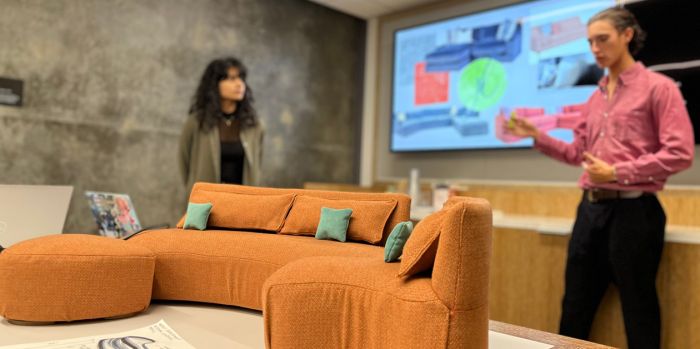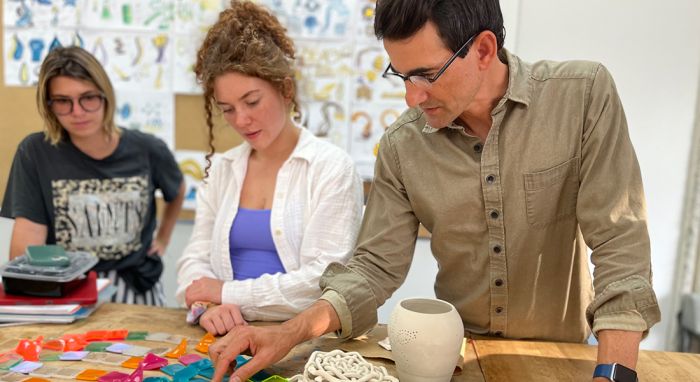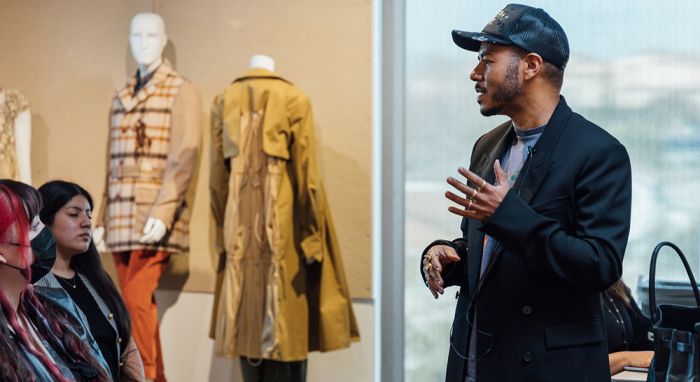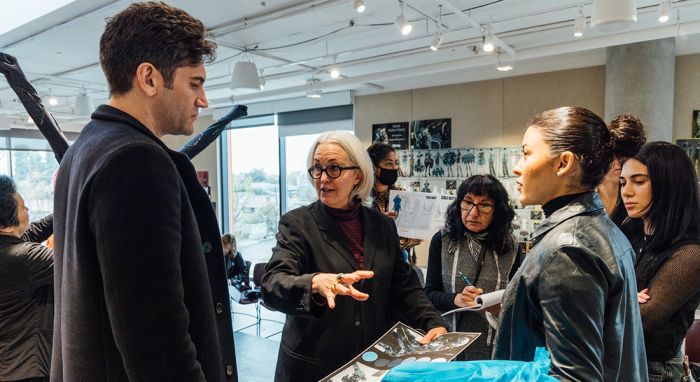Creating Beyond the Classroom: How Otis College’s Academic Collaborations Forge Real-Life Opportunities
From designing furniture and working with notable fashion brands to fabricating costumes for video game characters, Otis College students are prepared for life after graduation.

Otis College Product Design students pitch at furniture company Jonathan Louis. Photography courtesy Jonathan Louis.
It was pitch morning at furniture company Jonathan Louis. The leadership team was hard at work, deliberating the merits and marketability of several new sectional sofa designs at their Santa Monica headquarters. They listened to presentations, considered market research, examined small-scale models, and listened to the designers pitch their concepts, all of which were aimed at catering to Gen Z consumers. Then the team—which included sales, marketing, and the company’s CEO—chose one of the concepts to be built as a full-scale prototype and showcased at an upcoming industry trade show.
What’s most exciting about this sectional, and the others that were considered, is that they weren't created in-house at Jonathan Louis. Instead, they were born of the passion, imagination, and ingenuity of Otis College students.
The sectional sofa project was the culmination of Jonathan Louis’s semester-long sponsorship of a studio class in the Product Design department. It was the latest evolution of the brand’s partnership with the College, which began in 2021 when it collaborated with Otis Design Lab on furniture designs and trend forecasts. According to Heidi Gonzalez, the Director of Product Development at Jonathan Louis, it’s a partnership they hope to expand.
“It was such an amazing collaboration,” Gonzalez says. “We absolutely enjoy the interactions with the students and it excites us for the future. Even if they don’t end up [working for] us or in the furniture industry, it’s just amazing the amount of creativity that’s going to be implemented in product development moving forward.”
“When somebody is 100 percent creative, there are no limits. That’s what’s refreshing about the students: they come into the environment so pure. It really pushes us outside of our comfort zone.”
Gonzalez conceptualized the class and worked with Product Design faculty member Robert Creighton to create the curriculum, which included explorations into materials and manufacturing in addition to the final furniture design. Throughout the semester students worked closely with executives at Jonathan Louis, understanding the brand, touring the manufacturing facility, collaborating with one another, and learning how to incorporate business constraints into their designs—invaluable real-world experience.
“Participating in a class like this helps the students gain confidence in conversations with professionals,” Creighton says. “They learn how to speak with and take feedback from potential clients.” It also allows partners to experience a fresh perspective from student designers who are empowered to challenge the status quo.

Product Design faculty member Robert Creighton, right, works with students on a Jonathan Louis project. Photography courtesy Jonathan Louis.
“Partnering with these students is a great way for us to find inspiration and helps us think differently,” Gonzalez says. “When somebody is 100 percent creative, there are no limits. That’s what’s refreshing about the students: they come into the environment so pure. It really pushes us outside of our comfort zone.
That’s exactly what Creighton wants students to be comfortable doing. “My hope is that we are training future product designers by helping them to think differently about the future of how we live,” he says. “This requires them to reconsider everything about how we make products, operate businesses, and consider the environmental conditions. Product designers have the ability to be at the center of this conversation, and I hope that is where our students will work.”
Reigniting that Creative Spark
Valuing creativity also drives Leonardo Lawson and his partnership with Otis College’s Fashion Design department. “Working with students and being surrounded by that new energy and that excitement for the industry is invigorating,” he says. “Not to say that designers lose that, but as you can imagine, year after year, some designers don’t have that magical spark all the time, and the students do.”
Lawson first began working with Otis College in 2018, when the fashion and creative management consulting firm he founded, BOND Creative MGMT, helped secure mentors for the school’s Black Creatives Institute program. “I spoke to one of the classes on their first day, and from there my relationship with Otis just continued to blossom,” he says.
Lawson first joined the Board of Governors, then the Board of Trustees, continuing to raise awareness about Otis College and “the rock star creative school that it really is.”

Otis College Trustee Leonardo Lawson addresses Fashion Design students during his mentorship. Photograph by Danielle Vega/Otis College of Art and Design.
He has run fashion brands of every size, from boutique to billion-dollar, most recently as the head of Yeezy Gap, where he oversaw the Yeezy Gap Engineered by Balenciaga collaboration. When he mentored one of the Fashion Design program’s senior projects this year, he used work by Balenciaga’s creative director, Denma, as the inspiration. Students were tasked with designing a “unisex uniform for the modern warrior,” creating collections utilizing organic shapes and versatile materials. Some of those designs will be showcased at the annual Otis Atelier fashion show fundraiser.
Throughout the semester, Lawson met with students for sketch reviews, fabric selections, and multiple fittings, giving them an experience similar to the kind his professional clients receive.
“Working with students and being surrounded by that new energy and that excitement for the industry is invigorating.”
“I was very impressed with the outcome,” he says. “It shows the dedication and leadership of Jill [Zeleznik, Chair of Fashion Design] and her team, and the passion and commitment they have for the students to make sure that they are prepared for this.”
In addition to mentoring his own project, Lawson orchestrated several other noteworthy partnerships for the program, bringing on mentors that included Gap’s Jonathan Kirby, as well as Marcus Clayton, who has held design director positions at Alexander Wang, Givenchy, and LVMH.
“That’s the dream for most design students, to one day work for a luxury house,” Lawson says. “So I felt it was very important to bring in someone at that level, so they can hear firsthand and understand what it’s like to work in a luxury house.”
The experience can be just as beneficial for the mentors, giving them an intimate opportunity to understand what the next generation is drawn to, says Lawson: “It’s better than any marketing report you can buy.”
Students Exceeding Expectations
Exposure to what a desirable industry is truly like is one of the greatest benefits of these kinds of partnerships. It’s particularly true of the Fashion Design department’s growing relationship with Activision, the company behind some of the video game industry’s most well-known franchises, including Call of Duty, Diablo, Guitar Hero, and Tony Hawk. Last year, Fashion Design students developed a digital fashion collection on 3D models, inspired by several Call of Duty games. This year, using the same Marvelous Designer program, students created a moving avatar, dressed in their high-fashion designs inspired by the game Diablo. Each Fashion Design student collaborated with a fellow Otis student from the Digital Media program to create a custom environment for the avatar.

Activision’s Senior Art Director Tim McGrath and Costume Designer Louise Mingenbach review sketches during a mentorship session with Otis College Fashion Design students. Photograph by Danielle Vega/Otis College of Art and Design.
Tim McGrath, Activision’s Senior Art Director, was so pleased with last year’s all-digital collaboration that he wanted to explore not only another all-digital project, but also one with a more involved mentorship aspect that included real-life fabrication. For the latter project, students used Call of Duty: Infinite Warfare as inspiration, working with McGrath and Costume Designer Louise Mingenbach to bring one look from their collection to life. Students even got to tour Activision’s motion capture studio and see the different areas of game design in action, which includes an entire department dedicated to concept art. Despite those internal resources, Activision and others find exceptional value in partnering with Otis.
“They’re interested in fashion from our point of view because we come with a different mindset and a different articulation, as opposed to designers who are geared toward their world of gaming,” Zeleznik says. “I think they’re fascinated by how much detail our students put into the clothing, because it will blow your mind.” Zeleznik continues, articulating the reason at the heart of each wholly successful partnership: “The students will rise to the level we need them to. It’s a really magical kind of experience.”
